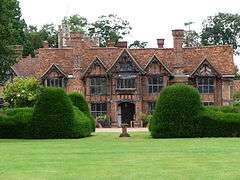Dorney Court
| Dorney Court | |
|---|---|
 Dorney Court, front facade | |
| General information | |
| Type | Stately home |
Dorney Court is a grade I listed early Tudor manor house, dating from around 1440, located in the village of Dorney, Buckinghamshire.[1] It is owned and lived in by the Palmer family.
Early history
Dorney Manor is recorded in the Domesday Book of 1086, as having been held before the Norman Conquest by Aldred, a man of Earl Morcar. In 1086, it was among the lands of Miles Crispin, and his tenant was a certain Ralf. From here it passed successively to families named Cave, Parker, Newnham, Paraunt, Carbonell, Scott, Restwold, Lytton, Bray, and Hill. In 1542, James Hill sold Dorney to Sir William Garrard, later Lord Mayor of London, and ancestor of the Palmer family which still owns and occupies Dorney Court today.[2]
Acquisition by Palmer family
Sir William Garrard, who bought the manor of Dorney from James Hill in 1542, served as Lord Mayor of London in 1555. He died in 1571, and was succeeded by his elder son, also called Sir William Garrard, who died in 1607 to be succeeded by his younger brother, Sir John Garrard.[3]
The daughter of Sir William Garrard was Martha (died 1617), who married James Palmer (later Sir James Palmer, knighted 1629), and Dorney Court was acquired by her husband in 1624. This followed disputes within the Garrard family over the property, centred on Martha's brother Thomas Garrard, who married against the wishes of his father and whose own wife with her family also embroiled him in disputes.[2]
Sir James Palmer (1585–1658), first of the Palmers of Dorney Court, was a younger son of Sir Thomas Palmer, baronet, of Wingham, Kent. He was Gentleman of the Bedchamber to James I and Charles I, Chancellor of the Order of the Garter (from 1645), a personal friend of Charles II, and an artist and miniature painter. He was also an adviser to the royal collection, and governor of the Royal Tapestry Works, Mortlake. His portrait of James I is in the Victoria & Albert Museum collection, his portrait of the Earl of Southampton is in the Fitzwilliam Collection, Cambridge and his portrait of the Earl of Northampton is in the Royal Collection.[4]
From Sir James, Dorney Court has passed from father to son in direct succession in the Palmer family down to the present day. His younger son was created Earl of Castlemaine but his older son inherited Dorney (Sir Philip Palmer, 1615–1683). Sir Philip's fourth but, at his death, oldest surviving son was Charles Palmer of Dorney (1651–1714).[2]
Charles Palmer's son inherited a baronetcy previously held by the senior branch of the family, the Palmers of Wingham in Kent. He therefore in 1723 became Sir Charles Palmer, 5th baronet, of Dorney. His own son, also called Charles Palmer, died before him, and so he was succeeded at his death by his grandson, Sir Charles Harcourt Palmer, 6th baronet, of Dorney.[2]
Sir Charles Harcourt Palmer of Dorney, 6th and last baronet, had a number of children by his cousin, but no marriage was proved, and so the children were illegitimate and the title came to an end at his death in 1838 (see G.E.C.'s Complete Baronetage vol I (1900) s.v. Palmer, and also Burke's Extinct Baronetcies). Dorney Court, however, continued to be inherited by succeeding generations of the Palmer family.[5]
Dorney Court is still privately owned and lived in by Jill Palmer (widow) and her sons: James, Freddie and Leopold Palmer.
Building
On first appearances the building appears to be entirely medieval, but in fact some of the exterior is a Victorian reconstruction. The remodelling of the house was undertaken at the end of the nineteenth century and the original bricks were restored to the front facade of the house. The interior layout of the house is little changed from 1500. The oldest part of the house is the panelled parlour, which contains some very fine examples of antique furniture.[6] The great hall has numerous family portraits and contains linenfold panelling brought from Faversham Abbey, in times past it was used to hold the Manor court and it is still the site of the annual Commoners meeting.[6]
The house has been open to the public since 1981. It has featured as a location in numerous films and TV programmes, such as Midsomer Murders, ITV's Agatha Christie's Poirot episodes "The Adventure of the Western Star" and "Sad Cypress", 24: Live Another Day, Zombies, Pride and Prejudice and The New World.[7][8]
References
- ↑ Historic England. "Dorney Court (1124439)". National Heritage List for England. Retrieved 10 July 2015.
- 1 2 3 4 Victoria County History of Buckinghamshire s.v. Dorney (vol 3, 1925) pp 221–225.
- ↑ Burke's Extinct Baronetcies (1841) s.v. Garrard of Lamer
- ↑ Sir James Palmer, Oxford Dictionary of National Biography
- ↑ Burke's Landed Gentry (1952 edition) "Palmer of Dorney Court"
- 1 2 The Country Life book of Castles and Houses in Britain. ISBN 0-600-35867-4.
- ↑ "Locations : Dorney Court : The Adventure of the Western Star". IMDB.com. Retrieved 2013-11-15.
- ↑ "On location with Poirot". Retrieved 4 July 2015.
External links
| Wikimedia Commons has media related to Dorney Court. |
Coordinates: 51°30′09″N 0°40′33″W / 51.50246°N 0.67593°W